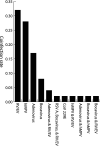Respiratory Pathogen Coinfections in SARS-CoV-2-Positive Patients in Southeastern Wisconsin: A Retrospective Analysis
- PMID: 34668725
- PMCID: PMC8528126
- DOI: 10.1128/Spectrum.00831-21
Respiratory Pathogen Coinfections in SARS-CoV-2-Positive Patients in Southeastern Wisconsin: A Retrospective Analysis
Abstract
Severe acute respiratory syndrome coronavirus 2 (SARS-CoV-2), the etiological agent of coronavirus disease 2019 (COVID-19), has infected all age groups and disproportionately impacted vulnerable populations globally. Polymicrobial infections may play an important role in the development of SARS-CoV-2 infection in susceptible hosts. These coinfections may increase the risk of disease severity and pose challenges to the diagnosis, treatment, and prognosis of COVID-19. There have been limited SARS-CoV-2 coinfection studies. In this retrospective study, residual nucleic acid extracts from 796 laboratory-confirmed COVID-19-positive specimens, collected between March 2020 and February 2021, were analyzed using a Luminex NxTAG respiratory pathogen panel (RPP). Of these, 745 returned valid results and were used for analysis; 53 (7.1%) were positive for one or more additional pathogens. Six different respiratory viruses were detected among the 53 SARS-CoV-2-positive patient specimens, and 7 of those specimens tested positive for more than one additional respiratory virus. The most common pathogens include rhinovirus/enterovirus (RV/EV) (n = 22, 41.51%), human metapneumovirus (hMPV) (n = 18, 33.9%), and adenovirus (n = 12, 22.6%). Interestingly, there were no SARS-CoV-2 coinfections involving influenza A or influenza B in the study specimens. The median age of the SARS-CoV-2-positive patients with coinfections was 38 years; 53% identified as female, and 47% identified as male. Based on our retrospective analysis, respiratory coinfections associated with SARS-CoV-2-positive patients were more common in young children (≤9 years old), with white being the most common race. Our findings will likely prompt additional investigation of polymicrobial infection associated with SARS-CoV-2 during seasonal respiratory pathogen surveillance by public health laboratories. IMPORTANCE This examination of respiratory pathogen coinfections in SARS-CoV-2 patients will likely shed light on our understanding of polymicrobial infection associated with COVID-19. Our results should prompt public health authorities to improve seasonal respiratory pathogen surveillance practices and address the risk of disease severity.
Keywords: COVID-19; SARS-CoV-2; coinfections; polymicrobial infections; public health; respiratory pathogen panel.
Figures



References
-
- Zhu N, Zhang D, Wang W, Li X, Yang B, Song J, Zhao X, Huang B, Shi W, Lu R, Niu P, Zhan F, Ma X, Wang D, Xu W, Wu G, Gao GF, Tan W, China Novel Coronavirus Investigating and Research Team. 2020. A novel coronavirus from patients with pneumonia in China, 2019. N Engl J Med 382:727–733. doi: 10.1056/NEJMoa2001017. - DOI - PMC - PubMed
-
- Holshue ML, DeBolt C, Lindquist S, Lofy KH, Wiesman J, Bruce H, Spitters C, Ericson K, Wilkerson S, Tural A, Diaz G, Cohn A, Fox L, Patel A, Gerber SI, Kim L, Tong S, Lu X, Lindstrom S, Pallansch MA, Weldon WC, Biggs HM, Uyeki TM, Pillai SK, Washington State 2019-nCoV Case Investigation Team. 2020. First case of 2019 novel coronavirus in the United States. N Engl J Med 382:929–936. doi: 10.1056/NEJMoa2001191. - DOI - PMC - PubMed
-
- Ghinai I, McPherson TD, Hunter JC, Kirking HL, Christiansen D, Joshi K, Rubin R, Morales-Estrada S, Black SR, Pacilli M, Fricchione MJ, Chugh RK, Walblay KA, Ahmed NS, Stoecker WC, Hasan NF, Burdsall DP, Reese HE, Wallace M, Wang C, Moeller D, Korpics J, Novosad SA, Benowitz I, Jacobs MW, Dasari VS, Patel MT, Kauerauf J, Charles EM, Ezike NO, Chu V, Midgley CM, Rolfes MA, Gerber SI, Lu X, Lindstrom S, Verani JR, Layden JE, Illinois COVID-19 Investigation Team. 2020. First known person-to-person transmission of severe acute respiratory syndrome coronavirus 2 (SARS-CoV-2) in the USA. Lancet 395:1137–1144. doi: 10.1016/S0140-6736(20)30607-3. - DOI - PMC - PubMed
Publication types
MeSH terms
LinkOut - more resources
Full Text Sources
Medical
Miscellaneous

